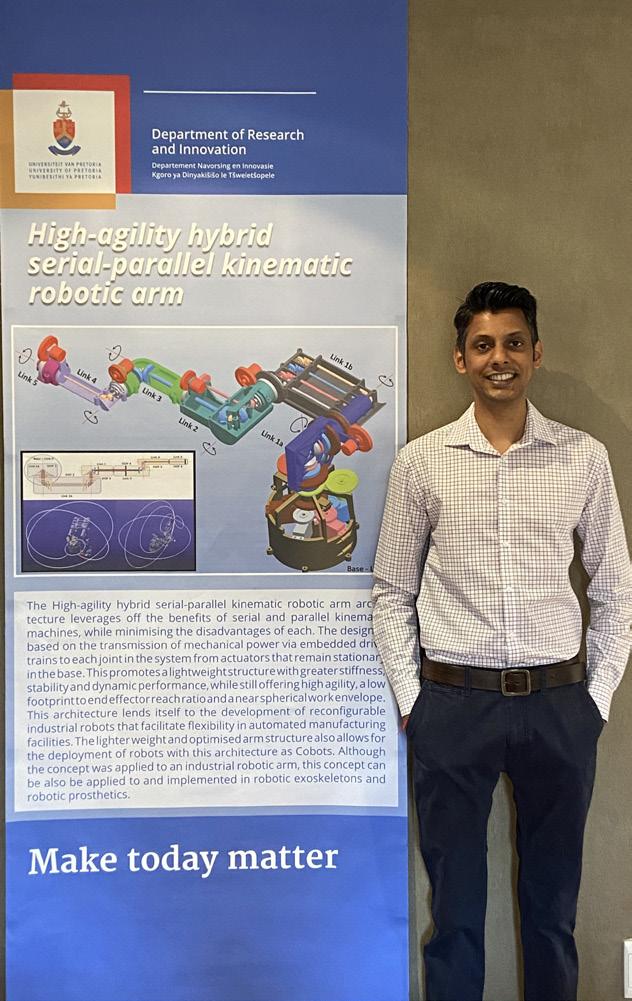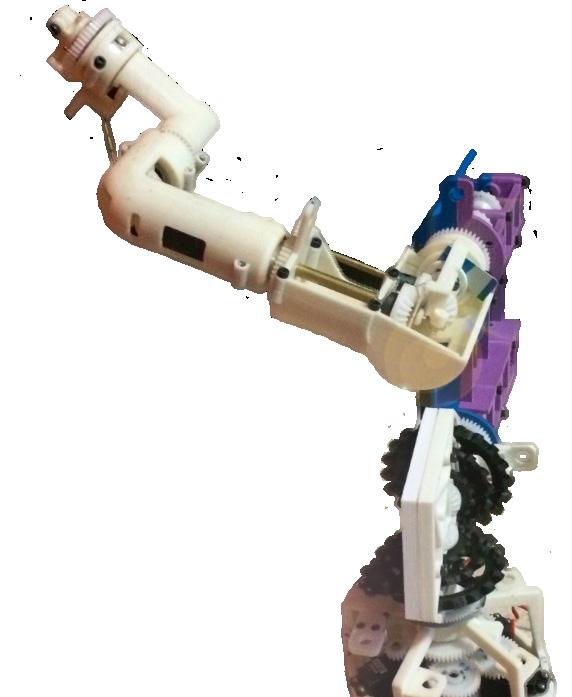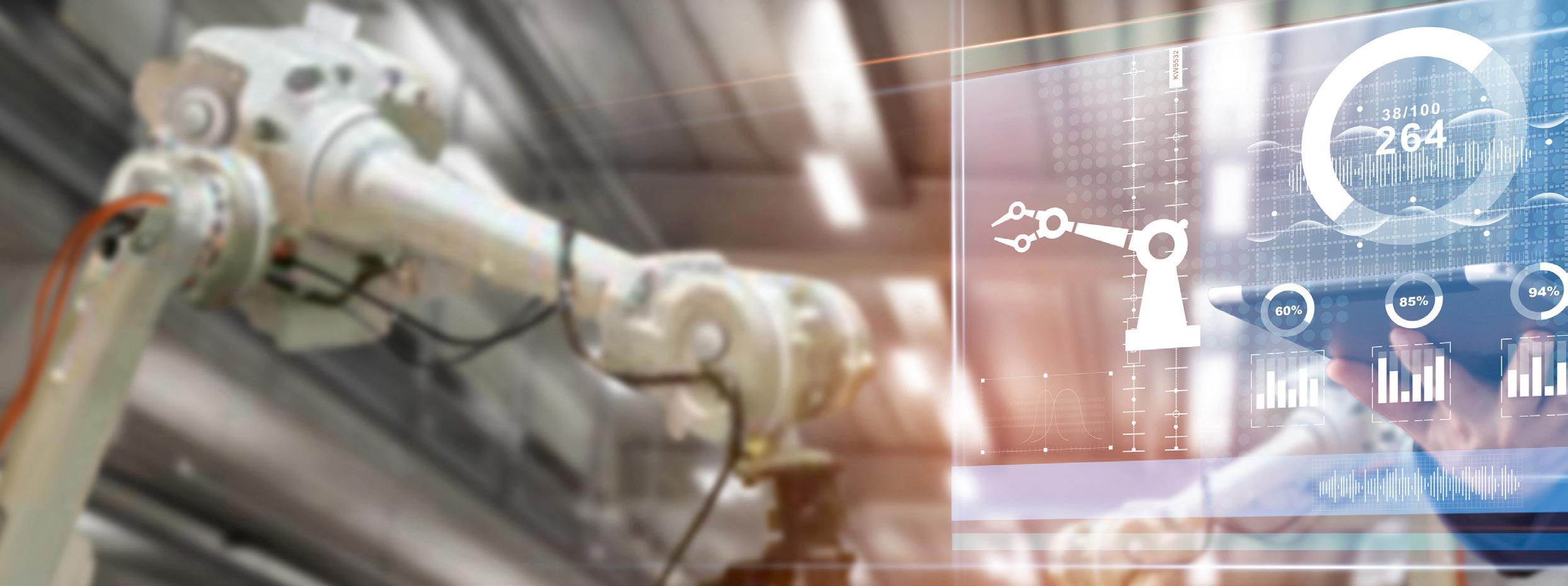
10 minute read
Kinematic robotic arm provides 6° of freedom
Kinematic robotic arm provides
Dr Sunveer Matadin
of freedom
I N N O V A T I O N FOCUS
Industrial robots are commonplace on workshop floors to perform repetitive tasks where a high degree of accuracy and repeatability is required. Existing models are based on one of two architectures: serial or parallel kinematic machines. While each has its advantages, there are also disadvantages associated with using either one of the two designs. Research aimed at optimising machine design and functionality, conducted in the University of Pretoria’s Department of Mechanical and Aeronautical Engineering, has resulted in a novel invention that considers the positive traits and trade-offs of both types.
As part of the research conducted to determine the benefits and drawbacks of existing models, a study was made of the two categories of robots presently in use. It was found that serial kinematic machines that consist predominantly of links interconnected with revolute joints are examples of open kinematic chains in which the actuator that activates the subsequent link is carried by the preceding link, although combinations of prismatic and revolute joints are also used for specific applications. This implies that each link carries the cumulative mass of all the links and their respective actuators that follow that link, in addition to the mass of the payload. Actuators therefore have to compensate by being higher powered in order to be put in motion and remain in motion, both in terms of the payload and the physical robot structure. The percentage of power used to actuate the physical robotic structure may be large considering that end effectors may carry low mass payloads such as spray guns.
The result is increased inertia and poorer dynamic performance at high velocities where high acceleration is required to reach the constant velocity on a typical trapezoidal velocity profile. It also has an adverse impact on the stiffness of the system and introduces unwanted vibration. This will adversely affect the accuracy of the end effector and repeatability of the system, while leading to higher power consumptions. This is especially true for higher order or degree of freedom (DOF) systems such as the 6 DOF systems that are commonly deployed due to their greater flexibility and operating workspace. Serial kinematic machines have the advantage of offering a larger workspace and a larger degree of agility, while also having a low footprint-to-end effector reach ratio (a small footprint to large end effector reach).
Parallel kinematic machines, on the other hand, are examples of closed kinematic chains. All the actuators that provide the required degrees of freedom are located on or closest to the base, hence ensuring the lowest centre of mass. This architecture improves dynamic response and performance, especially at high velocities and accelerations.
This design also offers reduced vibration and an increase in the system stiffness, pose stability, accuracy and repeatability of the machine. Power consumption and actuator torque requirements are reduced as the actuators do not need to be as heavy and high powered as the serial kinematic design since they do not need to put heavy subsequent links and actuators in motion. Link structures are also lighter than the serial kinematic design as they do not need the increased mechanical strength to carry subsequent actuators and links. The power required from actuators is used to predominantly move the payload or end effector and payload combination. The percentage of power used to actuate the physical robotic structure is therefore low and most of the power capacity is dedicated to the movement of the payload.
The new design proposed entails a novel concept in both the control system and mechanical architecture of a high-agility 6 DOF hybrid serial-parallel kinematic robotic arm. It would address the shortcomings of traditional serial and parallel kinematic machine architectures, while preserving the benefits of each of the two designs.
AN IDEAL SYSTEM WOULD BE ONE THAT OFFERS HIGH ACCURACY, REPEATABILITY AND DYNAMIC PERFORMANCE AT HIGH SPEEDS, ALONG WITH LOW VIBRATION, HIGH SYSTEM STIFFNESS, AGILITY, A LOW FOOTPRINT-TOEND EFFECTOR REACH RATIO AND A LARGE OPERATING WORKSPACE, WHILE SUPPORTING PRISMATIC AND REVOLUTE JOINTS.
Parallel kinematic machines have the disadvantage of having a large footprint, hence the high footprint-to-end effector reach ratio (a large footprint to small end effector reach), relatively small operating workspace and reduced agility.
An ideal system would be one that offers high accuracy, repeatability and dynamic performance at high speeds, along with low vibration, high system stiffness, agility, a low footprint-to-end effector reach ratio (a small footprint to large end effector reach) and a large operating workspace, while supporting prismatic and revolute joints. In order to realise these objectives, an architecture and control system that includes the positive traits and trade-offs of both parallel and serial kinematic machines must be considered. This system must also be based on the transmission of mechanical power through the system instead of electrical power.
Earlier attempts have been made to solve this problem. These have taken on various forms and have proposed the repositioning of actuators and the use of several power transmission philosophies, including chain and belt drives, tendons and pulleys, linkages and gears. Very early attempts often only document a mechanical system with no indication or proof of a control system that ensures the accurate and repeatable operation of the system in its entirety.
The new design proposed entails a novel concept in both the control system and mechanical architecture of a high-agility 6 DOF hybrid serialparallel kinematic robotic arm. It would address the shortcomings of traditional serial and parallel kinematic machine architectures, while preserving the benefits of each of the two designs. It would therefore need to include the following attributes:
The robotic arm would need to take the form of a traditional serial kinematic machine that contains a series of links, where each link is attached to the link preceding it.
Each link should offer a degree of freedom so that the entire system offers six degrees of freedom.
All motors that power the links in the system should be housed in the base of the robotic manipulator as is the case in a traditional parallel kinematic machine.
All motors should remain stationary at all times, and power should be transmitted mechanically from the motors to the respective link by means of a drive train.
It should be possible to rotate each link 360 degrees in both clockwise and counter-clockwise directions. It should also be possible to control each link individually and to move each link to a desired location, regardless of the motions of other links in the system.
This research topic was proposed by Sunveer Matadin and was completed in February 2019 as a doctoral research project under the supervision of Prof Nico Theron. The invention emanating from it is in the process of being protected and applied to an industrial robotic arm.
It can, however, also be implemented in robotic exoskeletons and prosthetics. Opportunities to commercialise the invention in any of the many forms that it can be applied are being investigated and any proposals to this end are welcomed.
The new invention introduces a hybrid concept for a robotic arm manipulator that aims to leverage off the benefits of serial and parallel kinematic machines, while minimising their disadvantages. The hybrid system’s link architecture, which is one of two kinematic chains in the system, takes the form of a serial kinematic machine, and the motors that power these links are fixed and located at the base of the system, as with a parallel kinematic machine.
Power is transmitted from motors to their associated links via drive trains composed exclusively of gear and shaft combinations. The second kinematic chain is formed by the drive trains embedded within the links that form the body of the manipulator. The drive train configurations can take the form of purely parallel link-embedded shafts, purely concentric link-embedded shafts or a combination of the two. The concept that was initially proposed comprised a combination of parallel and concentric linkembedded drive trains.
When analysing the mechanical architecture, both the physical model and the simulation model indicated an unwanted induced
component of motion for each link when the links lower down in the system are in motion. This is due to the mechanical coupling of the two kinematic chains and meant that, although the link architecture takes the form of a traditional serial kinematic machine, the system is a closed-loop system, as in the case of a traditional parallel kinematic machine. The induced component altered the intended trajectory and the end position of a link, which indicated that, other than the first link in the system, all other links could be put in motion by movements other than the actuator powering it. The intended trajectories and end position would have been realised for a given input if the induced component was not present. The input referred to has been termed the natural component of motion.
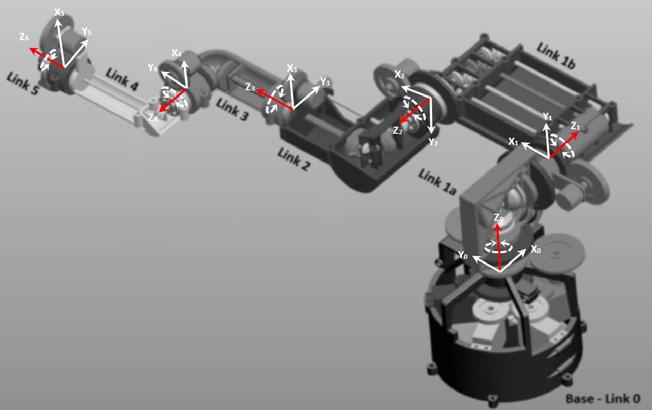
Joint rotations
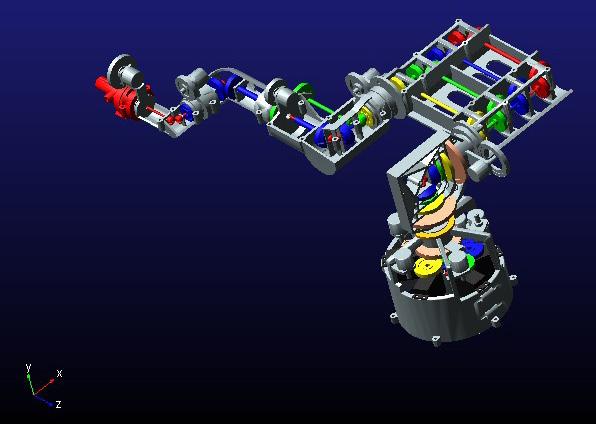
A crucial element in the study was the design and implementation of control algorithms that would negate the effects of the induced component of motion, leaving only the desired motion. These control algorithms were written into a program, along with equations that determined the trajectory for each link based on the present link position, the desired next link position and the period of time allowed for the movement from one position to the next.
Subsequent tests carried out on the hybrid system indicated that the control algorithms successfully nullified the induced component of motion, hence allowing links to produce the desired motion based on the natural component of motion. This proved that the proposed mechanical link and drive train architecture, in conjunction with the derived control algorithms, produced a hybrid serial-parallel kinematic manipulator that could offer the same freedom of movement, agility, reach and working envelope as a manipulator with serial kinematic machine architecture, even though all the motors were fixed at the base of the system.
When comparing the torque requirement of the hybrid system to that of a serial kinematic system with the same link architecture and masses, it was found that the hybrid system required between 20 and 25% less torque than the serial kinematic system, depending on the pose. It was noted that, even though the total mass of the drive train in the hybrid system was equal to the total mass of the motors distributed along the system in the traditional serial kinematic machine architecture, the torque requirements in the hybrid system were still less than those of the traditional system.
These results indicate that, in hybrid robotic systems, actuators with lower torque outputs than would be required in a traditional serial kinematic system can be used. This, by extension, leads to the possibility of smaller, lighter and lower-cost actuators being used in the hybrid system, compared to those required in the traditional system. It was also observed that the serial-parallel kinematic hybrid system offers an almost spherical working envelope, thus demonstrating the agility of the system.
The concept also lends itself to active and passive reconfigurability in that links can be extended via controlled prismatic joints or manually to alter the working envelope with a minimal increase in motor torque requirements. Furthermore, the system can be altered to manipulate larger payloads by simply changing the motor and not modifying the links. Designing the system with standardised joint gears allows for links to be changed to alter the working envelope.
